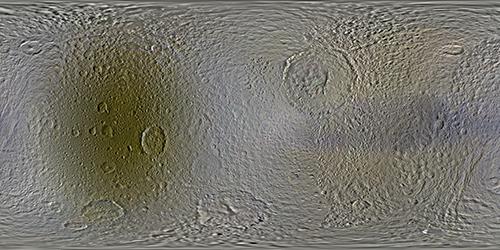Color Maps of Tethys (2014)

| PIA Number | PIA18439 |
|---|---|
| Language |
|
This global color mosaic of Saturn's moon Tethys was produced from images taken by NASA's Cassini spacecraft during its first 10 years exploring the Saturn system. This is one of the first global color maps of these moon produced from the Cassini data.
The most obvious feature on the maps is the difference in color and brightness between the two hemispheres. The darker colors on the trailing hemispheres are thought to be due to alteration by magnetospheric particles and radiation striking those surfaces. The lighter-colored leading hemisphere is coated with icy dust from Saturn's E-ring, formed from tiny particles ejected from Enceladus' south pole. These satellites are all being painted by material erupted by neighboring Enceladus.
Another dramatic feature is the moon's equatorial band. First observed on Tethys by Voyager, Cassini's color mapping also revealed a similar type of feature on Mimas. Cassini showed these areas on both moons to be significantly brighter in the ultraviolet than surrounding terrains. This pattern, localized on the leading hemispheres, was discovered to correlate with the predicted pattern of bombardment of high-energy electrons trapped in Saturn's magnetic field. This bombardment alters the surface ices on a crystalline scale and changes their color. Later, thermal observations by Cassini's Composite Infrared Spectrometer (CIRS) instrument showed that these features also form thermal anomalies on the surface, giving rise to the nickname "Pac-Man" features (See A Pair of 'Pac-Men').
The colors shown in these global mosaics are enhanced, or broader, relative to human vision, extending into the ultraviolet and infrared range.
Resolution on Tethys in the maps is 250 meters per pixel.
Image selection, radiometric calibration, geographic registration and photometric correction, as well as mosaic selection and assembly were performed by Paul Schenk at the Lunar and Planetary Institute. Original image planning and targeting for Saturn's icy moons were performed by Tilman Denk (Frei Universitat, Berlin) and Paul Helfenstein (Cornell University, Ithaca, New York).
Credit: NASA/JPL-Caltech/Space Science Institute/Lunar and Planetary Institute
